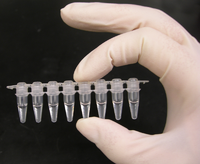
Photo from wikipedia
Small ruminant lentiviruses (SRLVs) are highly diverse retroviruses infecting sheep and goats. Although PCR-based testing is being utilized for diagnostics, its application is hampered by various factors. These include, among… Click to show full abstract
Small ruminant lentiviruses (SRLVs) are highly diverse retroviruses infecting sheep and goats. Although PCR-based testing is being utilized for diagnostics, its application is hampered by various factors. These include, among others, the exceptionally high genetic variability of SRLVs, as well as the low number of infected blood monocytes. For this reason, a highly sensitive and specific semi-nested real-time PCR for proviral DNA detection and quantification was developed. The method is innovative in that a) its design is based on selecting the preferred codon usage in the targeted conserved genomic regions and b) oligospermine-conjugated degenerate primers with increased Tm were utilized. Modifications permitted primer/template duplex formation in the cases of mismatches due to sporadic nucleotide polymorphisms in a number of variant SRLV strains and, consequently, the detection of highly diverse SRLV strains. The potential loss of analytical sensitivity and specificity was counterbalanced by including a semi-nested step in combination with LNA probes. An in silico procedure for the evaluation of hybridization efficiency of the designed oligonucleotides to all known targeted variants was also implemented. The method presents a linear range of quantification over a 3-log10 range and a limit of detection of 3.9 proviral dsDNA copies per reaction. Its diagnostic performance was evaluated by testing field samples from seropositive and seronegative animals, followed by phylogenetic analysis of the strains detected. In order to further increase the diagnostic sensitivity, a DNA extraction protocol for blood leukocytes was developed and evaluated so as to increase DNA yield. A minimum of 500 ng of input DNA is recommended for PCR-based detection of SRLV proviral DNA, given the low numbers of infected blood monocytes. The developed methodology may serve as a useful tool, which can be adjusted for the quantitative detection of viruses exhibiting high genetic variability.
Journal Title: Molecular and cellular probes
Year Published: 2020
Link to full text (if available)
Share on Social Media: Sign Up to like & get
recommendations!